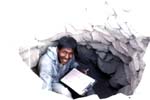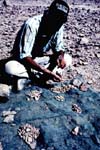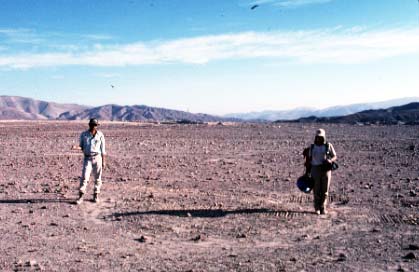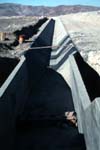 |
|
|
|
The Chen Chen Site (M1) |
The Chen Chen site (M1), covering approximately 30 ha of desert near the city of Moquegua, is one of the most important Tiwanaku sites outside of the altiplano. In 1995, the site faced imminent destruction by the construction of the Pasto Grande canal and the expansion of the city of Moquegua. The Proyecto Rescate Chen Chen was organized with the aim of recovering crucial data from the site prior to its destruction. The 1995 project was directed by Antonio Oquiche of the Museo Contisuyu in Moquegua. Mapping of the agricultural area associated with the site was undertaken by Ryan Williams. I was responsible for investigations in the habitation, storage and ceremonial sectors of the site.
Chen Chen is best known as the largest Tiwanaku cemetery, with the mortuary component covering well over 6 ha. Previous mortuary excavations include work by Disselhoff, Neira, Vescelius and Ravines (Disselhoff 1968) and by salvage operations directed by B. Vargas in the 1980s (Blom et al. 1998; Vargas 1989). 1995 work on the site's mortuary component was directed by Dr. Bruce Owen.
The habitation sectors at Chen Chen were unstudied before our
work in 1995. We mapped the entire site and its domestic sectors, and
concucted household archaeology excavations in a sample of ordinary domestic,
storage, and ceremonial units. Analysis of the distribution of artifacts
and architecture allow us to interpret the principal sectors of the site.
An outer habitation area housed a temporary population of agricultural
laborers or pastoralists, involved in the shipment of agricultural goods
produced in the field system associated with the site. State or clan level
rituals took place in a ceremonial area in the centrally located sectors
14 and 15. The largest permanent resident population was housed in sectors
11 and 12, which also included substantial storage and food-processing
facilities.

|
Copyright ©2003 Paul S. Goldstein. All rights reserved. |









